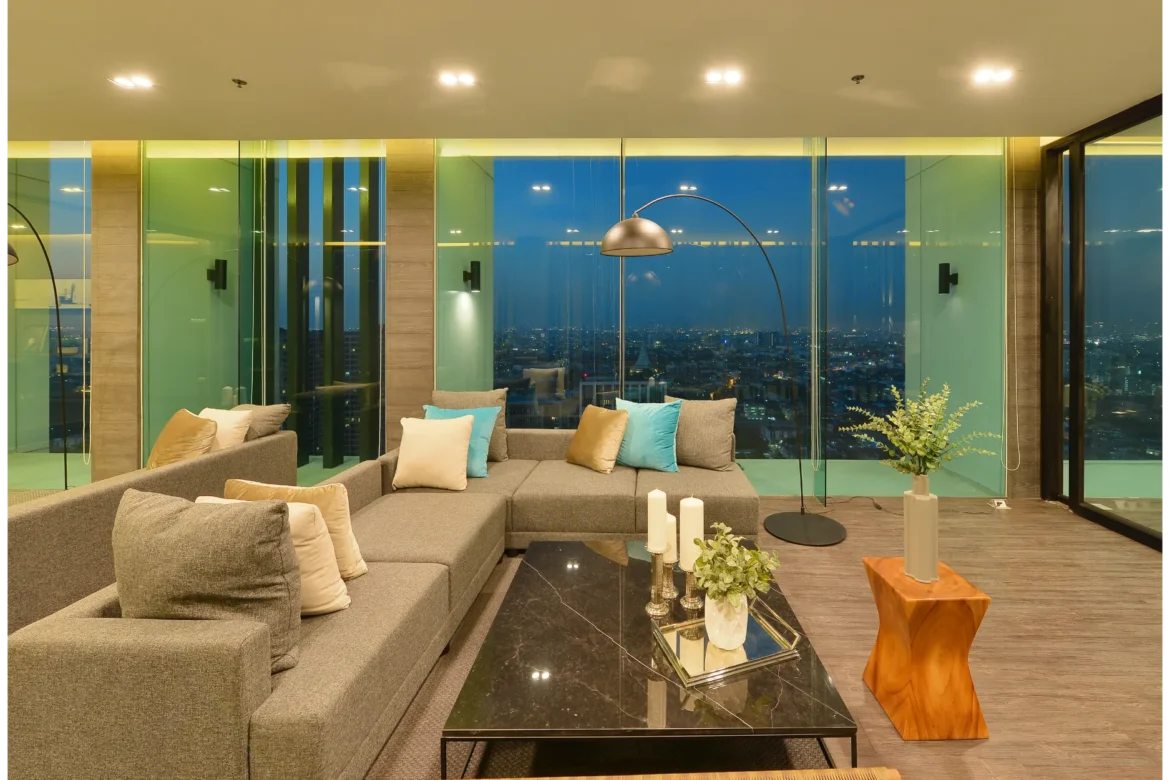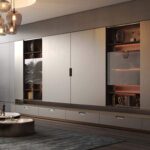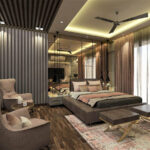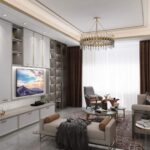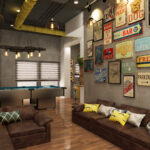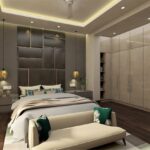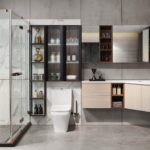Overview
Discover the magic of glass in interior design! From open spaces to chic styles, explore the versatility that glass brings to modern living.
Good design is obvious. Great design is transparent.
Joe Sparano
In the enchanting world of interior design, every choice, and every element plays a pivotal role in crafting spaces that resonate with beauty and functionality. The significance of material selection cannot be overstated; it is the very fabric that weaves together the narrative of a space. In this symphony of design, one material stands out for its unparalleled ability to transform interiors into open, airy havens – glass.
Glass, often celebrated for its transparency, is a design chameleon. It possesses a unique power to shape environments, playing with light and space to create atmospheres that are not only visually stunning but also inherently welcoming. As we venture into an exploration of the diverse capabilities of glass, it becomes imperative to grasp the profound influence it can exert on the holistic interior design of a space.
Imagine a room bathed in natural light, seamlessly extending beyond its physical boundaries. This is the magic of glass. Glass has an extraordinary capacity to dissolve barriers, making spaces feel larger, brighter, and more connected to the world outside. It’s not merely a construction material; it’s a design tool that architects and interior designers wield to craft environments that breathe and inspire.
This exploration is tailored for those who are the architects of these transformative experiences – the interior design professionals. Whether you are a seasoned designer or a budding enthusiast, the selection of materials is the brushstroke that defines your artistic expression. In this context, we turn our attention to the canvas that is glass, understanding its nuances, and delving into its applications to unlock the secrets of open and airy space design.
For the interior design professional, the journey through the versatility of glass is a journey into the heart of contemporary design. It’s about understanding how a material, often associated with fragility, can become the cornerstone of strength in design. So, let’s embark together on this odyssey, unraveling the layers of glass’s aesthetic allure and functional prowess, as we explore how it can elevate your creations to new heights. Welcome to a world where the transparency of glass mirrors the clarity of interior design thought – a world where space is not confined but liberated.
The Aesthetic Appeal Of Glass
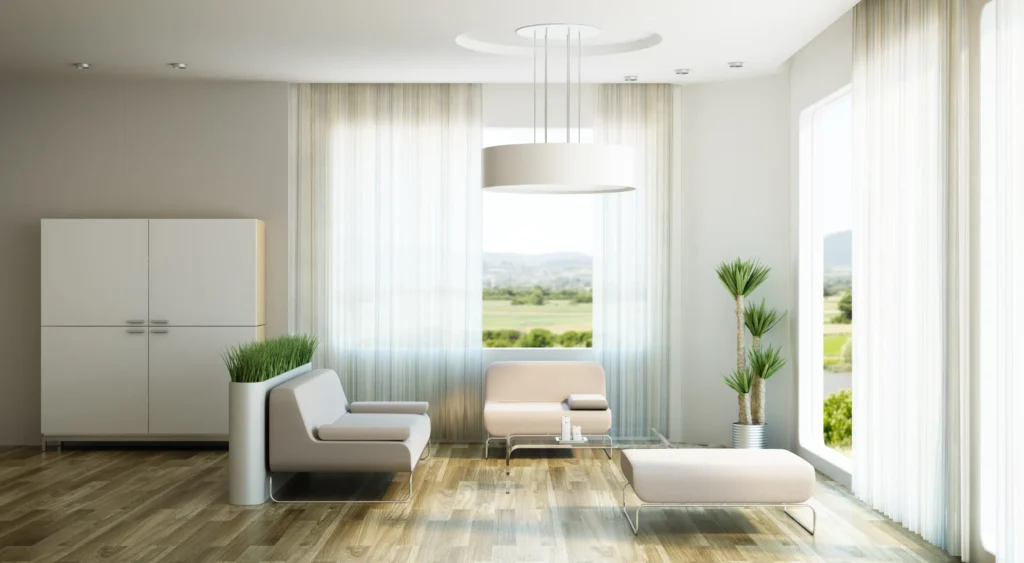
In the realm of interior design, the aesthetic appeal of materials is a cornerstone, and glass emerges as a versatile maestro, orchestrating a symphony of visual delight within spaces.
Transparency And Light Diffusion
Enhancing Natural Light
Glass acts as a gateway for natural light, transforming interiors into bright and inviting sanctuaries. The seamless infusion of sunlight not only imparts a sense of warmth but also contributes to a more sustainable and energy-efficient design. Spaces adorned with ample natural light become dynamic canvases, creating an atmosphere that transcends the confines of walls.
Consider, for instance, a modern living room’s interior design adorned with floor-to-ceiling windows or glass doors. The unrestricted flow of sunlight not only accentuates the interior elements but also fosters a connection with the external environment, blurring the boundaries between inside and outside.
Creating the Illusion of Space
The transparency of glass holds the power to deceive spatial limitations, making confined areas appear more expansive. Small rooms or tight corridors can benefit from the visual openness that glass provides, fostering an illusion of airiness and grandeur. Glass partitions, strategically placed, allow for delineation without sacrificing the perception of space.
Take, for instance, a cozy home office with glass dividers. The see-through panels maintain a sense of privacy while preserving the overall openness, making the room feel larger and more accommodating.
Reflective Properties Of Glass In Interior Design
Mirroring Outdoor Elements
Glass possesses reflective qualities that can seamlessly integrate a space with its surroundings. Mirroring outdoor elements such as lush greenery, scenic landscapes, or architectural features creates a harmonious blend between the interior design and exterior realms. This integration not only enhances the visual appeal but also establishes a connection to nature within the confines of the built environment.
Imagine a glass-walled dining area overlooking a serene garden. The reflective surfaces of the glass capture the beauty of the outdoor greenery, bringing nature into the dining experience and infusing the space with tranquility.
Adding Depth and Dimension to Interior Design
The reflective nature of glass contributes to the creation of depth and dimension within interiors. Mirrors and glass surfaces strategically placed can visually expand spaces, making them feel more dynamic and engaging. This is particularly effective in confined areas where traditional design elements might contribute to a sense of claustrophobia.
Consider a hallway adorned with mirrored walls. The reflections create an optical illusion of extended space, turning a narrow passage into a visually intriguing journey.
Versatility In Interior Design Styles
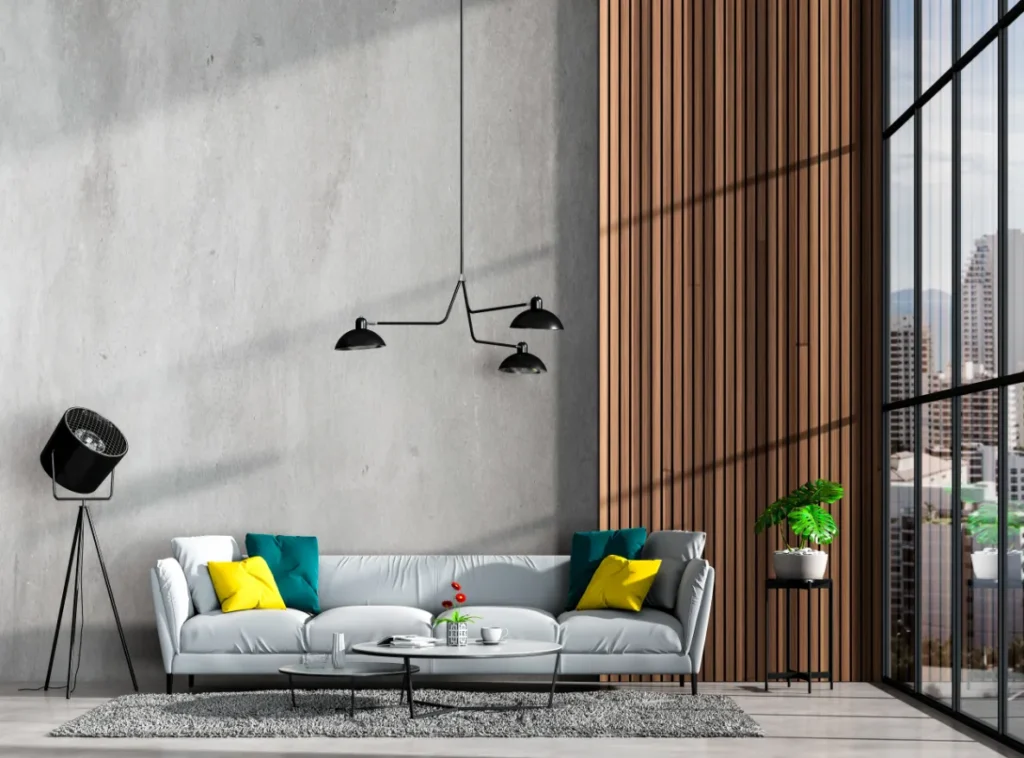
Modern And Contemporary Applications
Glass seamlessly integrates into modern and contemporary design styles, becoming a hallmark of sleek sophistication. Clean lines, minimalistic aesthetics, and open layouts characterize these design genres, and glass complements these features flawlessly. From expansive glass facades in urban dwellings to minimalist glass furniture, the material becomes a key player in achieving a modern, cutting-edge look.
Take, for instance, a contemporary kitchen with glass countertops and backsplashes. The transparency of the glass adds a touch of elegance while maintaining the overall modern aesthetic.
Traditional and Classic Interior Designs with a Modern Twist
Contrary to common perception, glass is not exclusive to modern design; it adapts seamlessly to traditional and classic styles with a contemporary infusion. Stained glass windows, ornate glass chandeliers, or glass accents in vintage furniture can bring a timeless appeal with a modern sensibility.
Picture a timeless library adorned with towering glass bookshelves that stretch from floor to ceiling. While the classical ambiance remains intact, the infusion of glass elements introduces a subtle touch of modernity, forging a seamless fusion between the traditional and the contemporary.
Functional Aspects Of Glass In Interior Design
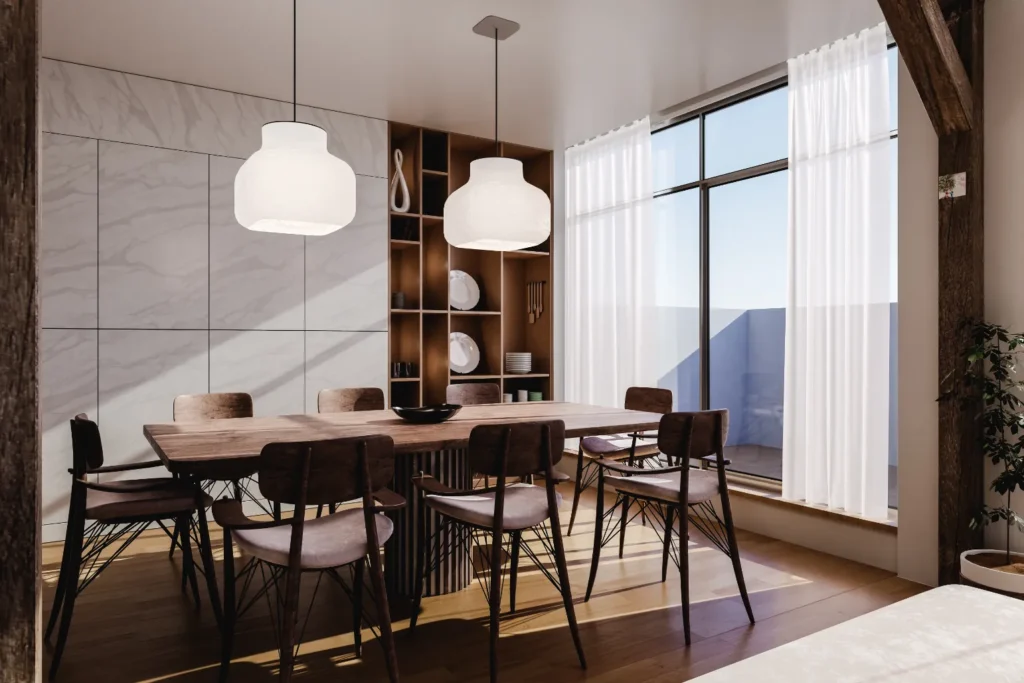
Space Division Without Visual Obstruction
Glass Partitions and Dividers
Glass serves as a subtle yet effective tool for dividing spaces without sacrificing the visual openness that characterizes modern design. Glass partitions and dividers, whether they are in residential or commercial spaces, create distinct zones while maintaining a sense of unity. For instance, in an open-plan office, glass partitions between workstations foster collaboration without the encumbrance of solid walls, fostering a transparent and collaborative atmosphere.
Maintaining an Open Feel in Various Rooms‘ Interior design
Glass’s unique ability to define spaces without closing them off makes it an ideal choice for maintaining an open feel in various rooms. Consider a home with a glass-walled study adjacent to the living room. The transparency of the glass allows the study to feel connected to the larger living space, ensuring that the open ambiance permeates throughout the entire home.
Seamless Indoor-Outdoor Transitions
Sliding Glass Doors and Walls
Glass plays a pivotal role in seamlessly connecting indoor and outdoor spaces. Sliding glass doors and walls, often employed in contemporary designs, provide a smooth transition between the interior and the external environment. In a residence, a living room adorned with expansive sliding glass doors can effortlessly transform into an open-air lounge, blurring the boundaries between the inside and outside.
Connecting Interior Design with Outdoor Environments
Imagine a restaurant with glass walls that open up to a scenic patio. The incorporation of glass enables diners to bask in the beauty of the outdoors while relishing the comfort of the indoor setting. This connection to nature not only enhances the dining experience but also creates a versatile and dynamic space that adapts to changing weather conditions.
Reflecting And Amplifying Artificial Lighting
Enhancing the Impact of Artificial Lighting Fixtures
Glass has a remarkable ability to enhance the impact of artificial lighting within a space. When strategically placed, glass surfaces can reflect and refract light, creating a visually stunning interplay of illumination. In the hotel lobby, a glass chandelier serves not only as a source of direct illumination but also as a reflector of its brilliance, enveloping the space in a welcoming and warm glow.
Creating a Well-Lit and Inviting Atmosphere
Glass’s light-amplifying properties contribute to creating well-lit and inviting atmospheres. In a retail setting, glass display cases can showcase products under optimal lighting conditions, drawing attention to the merchandise and creating an aesthetically pleasing shopping environment.
Glass As An Eco-Friendly Material
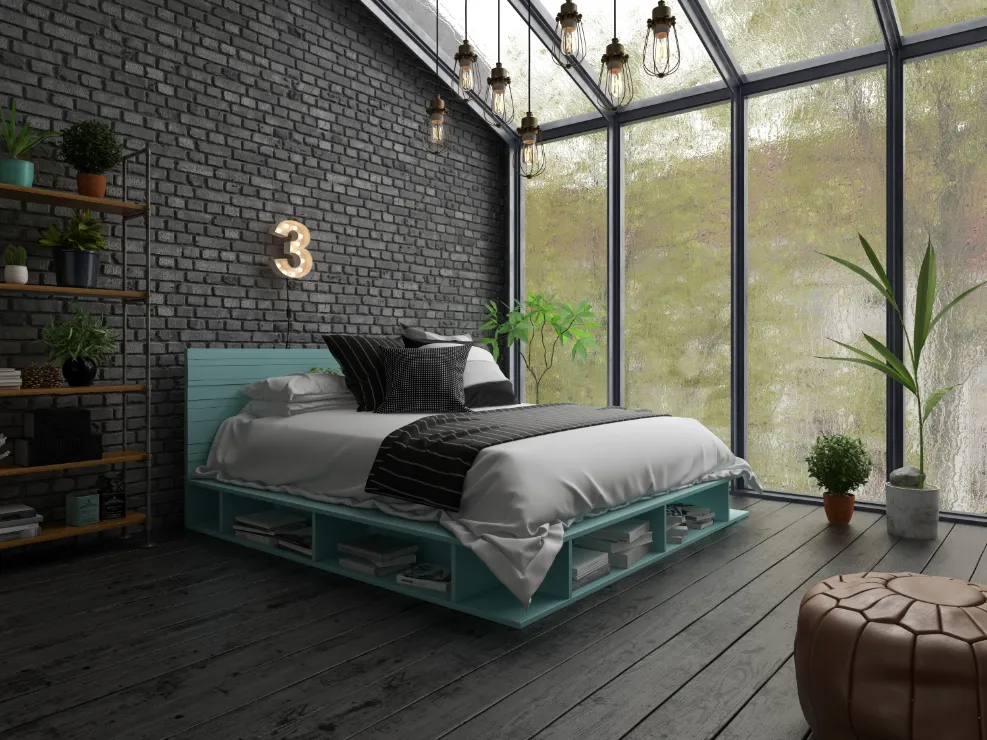
In the dynamic field of interior design, sustainability has become a cornerstone, and within this realm, glass emerges not just as a visual asset but as a sustainable advocate, contributing to energy efficiency and environmentally conscious design practices.
Enhancing Energy Efficiency In Temperature Control
Double-Pane and Low-Emissivity Glass’s Impact
Glass plays a pivotal role in regulating temperature within a space, actively contributing to both heating and cooling efficiency. The use of double-pane glass, consisting of two layers with a layer of gas in between, acts as a robust insulator. This design significantly reduces heat transfer, providing superior insulation against external temperature fluctuations. Complementing this, low-emissivity (low-E) glass coatings further improve energy efficiency by minimizing heat loss in colder seasons and heat gain in warmer periods.
Consider a contemporary residence featuring expansive windows made of double-pane, low-E glass. This not only optimizes natural light but also ensures top-notch thermal insulation, diminishing reliance on artificial heating or cooling systems.
Variable Impact on Energy Consumption in Different Climates
Glass’s impact on energy consumption is context-dependent, varying with climate conditions. In colder climates, well-insulated glass helps retain interior design’s warmth, diminishing the need for excessive heating. Conversely, in warmer climates, efficient glass controls heat gain, reducing reliance on air conditioning. The adaptability of glass to diverse climates underscores its versatility as a sustainable solution, catering to the distinct energy demands of different regions.
Embracing Recyclability And Environmentally Friendly Production
Comprehensive Life Cycle Analysis of Glass Products
Glass’s commitment to sustainability extends across its entire life cycle, from extraction of raw materials to production, transportation, and eventual disposal. Notably, the recyclability of glass stands out, as it can be recycled indefinitely without compromising quality. This reduces the need for fresh raw materials and alleviates the environmental impact linked to conventional manufacturing procedures.
Imagine a corporate environment featuring glass partitions. At the end of their life cycle, these glass elements can be recycled, contributing to a circular economy where materials are consistently repurposed, minimizing waste and environmental strain.
Integration of Sustainable Practices in Glass Manufacturing
The glass industry is actively adopting sustainable manufacturing practices, infusing eco-friendly initiatives into production processes. This includes incorporating recycled glass into the manufacturing of new products, effectively reducing the industry’s carbon footprint. Moreover, the implementation of energy-efficient technologies, such as electric melting furnaces, aids in lowering energy consumption during glass production.
Technical Considerations For Glass Selection
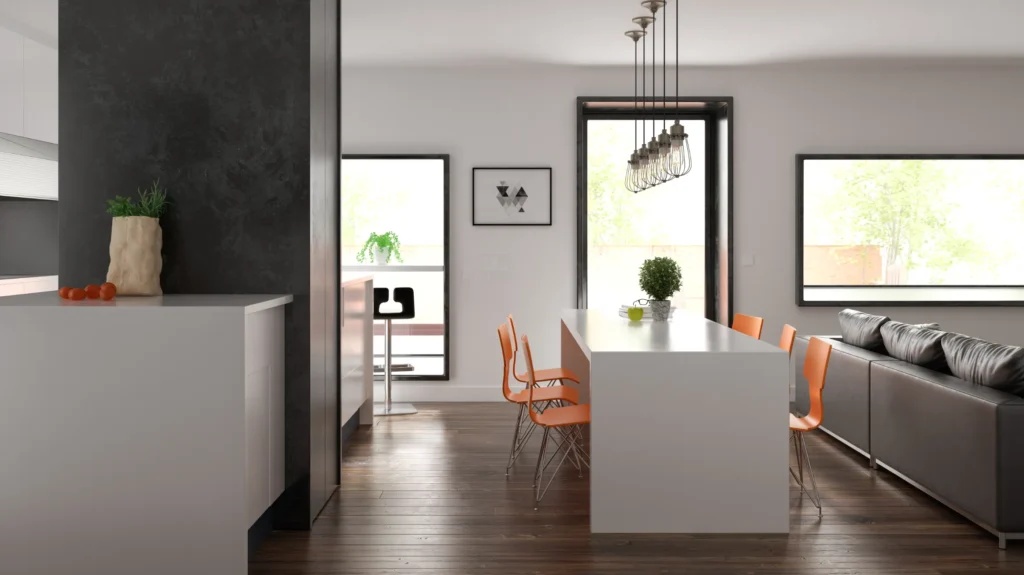
Types Of Glass For Different Applications In Interior Design
Clear Glass vs. Frosted or Textured Glass
The choice between clear, frosted, or textured glass is pivotal, influencing both aesthetics and functionality. Clear glass, with its transparency, is often favored when an unobstructed view or abundant natural light is desired. It’s a common choice for windows and glass doors, enabling a seamless connection between indoor and outdoor spaces.
Conversely, frosted or textured glass serves a distinct function. It provides privacy while still allowing light to filter through. In a bathroom setting, for instance, frosted glass shower enclosures offer both functionality and a touch of elegance, creating a private space without sacrificing light.
Safety Glass Options for Various Spaces
Safety is paramount, especially in high-traffic areas or places where the risk of breakage is higher. Tempered glass, a type of safety glass, undergoes a thermal treatment process that enhances its strength. In the event of breakage, tempered glass fractures into small, relatively harmless pieces, reducing the risk of injury. This makes it an ideal choice for applications like glass doors, partitions, and tabletops.
Laminated glass is another safety-oriented option. It consists of layers of glass with an interlayer of polyvinyl butyral (PVB) that holds the glass together upon impact. Widely used in applications like skylights and glass balustrades, laminated glass provides added security.
Thickness And Durability
Choosing the Right Thickness for Different Applications
The thickness of glass is a pivotal factor, and it fluctuates depending on the intended use. Thicker glass is often employed in structural elements such as glass floors or heavy-duty glass countertops. In contrast, thinner glass may be suitable for decorative elements like glass tabletops.
Consider a commercial space with a glass countertop in a reception area. The choice of thicker glass ensures durability and can withstand daily wear and tear, maintaining both functionality and aesthetic appeal.
Impact Resistance and Safety Standards
Beyond thickness, understanding impact resistance is crucial for ensuring the safety and longevity of glass installations. Glass undergoes standardized tests to determine its impact resistance, with ratings indicating the force it can withstand. This is particularly important in areas prone to potential impact, such as glass railings in public spaces.
Adherence to safety standards, such as those set by organizations like the International Building Code (IBC) or ASTM International, ensures that glass installations meet prescribed safety measures. This is imperative for applications like glass doors and partitions in commercial buildings, where safety is paramount.
Conclusion
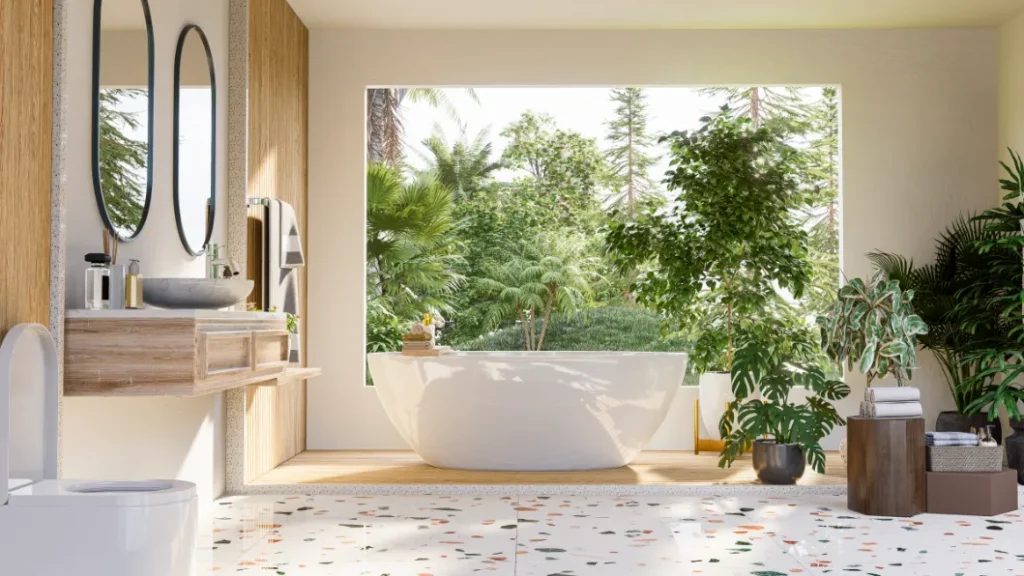
As we conclude this exploration into the multifaceted world of glass in interior design, let’s revisit the key facets that make it an indispensable ally in the hands of design enthusiasts.
Throughout our journey, we’ve witnessed how glass transcends mere functionality, becoming a design element that enhances both form and atmosphere. Its transparency breathes life into spaces, creating an illusion of openness that is particularly cherished in the contemporary design landscape. From clear expanses that invite natural light to textured or frosted surfaces that balance privacy and luminosity, the possibilities seem limitless.
Glass, with its reflective properties, adds a dynamic layer to interiors, mirroring outdoor elements and infusing spaces with depth. Whether it’s seamlessly dividing rooms with transparent partitions or facilitating a smooth transition between indoor and outdoor realms, glass proves to be an aesthetic chameleon, adapting to various design styles with finesse.
As we bid farewell to this exploration, the journey doesn’t end but beckons us towards uncharted territories of innovation. The world of glass in interior design is dynamic, and continuously evolving with advancements in technology and sustainable practices. The invitation is extended to interior design professionals to push boundaries, experiment with new applications, and redefine the possibilities of glass.
Innovative glass applications, from smart glass technologies that dynamically respond to environmental conditions to biophilic designs that seamlessly blend the natural world with interiors, await exploration. The challenge is not just to see glass as a medium but as a canvas for creativity and functionality, where each installation tells a unique story of design ingenuity.
In the ever-evolving landscape of interior design, where trends may come and go, the enduring allure of glass remains constant. It is not merely a material; it is a conduit for elevating design to new heights. So, let us embark on future projects with a newfound appreciation for the transformative power of glass, turning the ordinary into the extraordinary, one pane at a time.
At The White Frame, we turn extravagant dreams into functional, well-crafted realities. We handcraft luxurious homes, tailored to the preferences of our diverse clientele in Gurgaon, Noida, and Delhi-NCR. We’re redefining the notion of modern opulence, proving that luxury doesn’t have to strain the budget. We’re driven by a core belief that our in-house technology (Twinn) streamlines processes, making the journey to your dream home effortless and trouble-free. Our team of designers is well-versed in optimizing space and crafting functional, aesthetically pleasing interiors that exude class, sophistication, and beauty.
Explore some of our work here and Get in Touch with us Today!


